
This lesson will identify the cause and effects of various blood disorders. [5:21]
- Subject:
- Science
- Material Type:
- Audio/Video
- Provider:
- Sophia Learning
- Date Added:
- 12/01/2023

This lesson will identify the cause and effects of various blood disorders. [5:21]
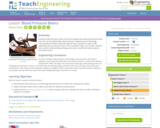
Students study how heart valves work and investigate how valves that become faulty over time can be replaced with advancements in engineering and technology. Learning about the flow of blood through the heart, students are able to fully understand how and why the heart is such a powerful organ in our bodies.

The purpose of this lesson is to teach students about blood and its components while instilling an appreciation of its importance for survival. The lesson takes a step-by-step approach to determining the "recipe" for blood while introducing students to important laboratory techniques like centrifugation and microscopy, as well as some diseases of cell types found in blood. [35:52]

In this video segment, adapted from NOVA, Dr. Judah Folkman uses the scientific method to discover how cancer cells induce the formation of new blood vessels, which in turn nourish those cancer cells.

Students will learn about the nitrogen and phosphorus cycles and investigate how these nutrients are cycled through the ecosystem near Toledo, OH, eventually causing significant algal blooms that threaten the water supply along the western coastline of Lake Erie.
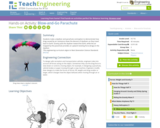
Students make a skydiver and parachute contraption to demonstrate how drag caused by air resistance slows the descent of skydivers as they travel back to Earth. Gravity pulls the skydiver toward the Earth, while the air trapped by the parachute provides an upward resisting force (drag) on the skydiver.

A 90 minute laboratory experiment utilizing observations and reasoning regarding the Law of Conservation of Matter and Energy.

Canadian Wildlife site features the Blue Jay. Highlights its habitats and habits, range, feeding and breeding characteristics.

If you’ve seen Bitty and Bob at the Museum, you know bobcats are incredible animals. They can leap as far as 12 feet and have a keen sense of smell. In this week’s edition of Wildlife Wednesdays, learn even more fast facts about these felines with wildlife specialist Nikki McClellan. Worksheets available for grades PreK-K and 1-2.

Los estudiantes diseñan, construyen y prueban vehículos de carreras hechos de bobinas de manualidades.

Students are introduced to the circulatory system, the heart, and blood flow in the human body. Through guided pre-reading, during-reading and post-reading activities, students learn about the circulatory system's parts, functions and disorders, as well as engineering medical solutions. By cultivating literacy practices as presented in this lesson, students can improve their scientific and technological literacy.

Throughout the day, your nervous system monitors and makes endless adjustments to your body's basic systems--all to keep you alive. This interactive feature illustrates the complexity of such a task.

Throughout the day, your nervous system monitors and makes endless adjustments to your body's basic systems -- all to keep you alive. This interactive feature illustrates the complexity of such a task.
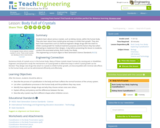
Students learn about various crystals, such as kidney stones, within the human body. They also learn about how crystals grow and ways to inhibit their growth. They also learn how researchers such as chemical engineers design drugs with the intent to inhibit crystal growth for medical treatment purposes and the factors they face when attempting to implement their designs. A day before presenting this lesson to students, conduct the associated activity, Rock Candy Your Body.
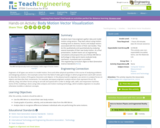
Students learn how engineers gather data and model motion using vectors. They learn about using motion-tracking tools to observe, record, and analyze vectors associated with the motion of their own bodies. They do this qualitatively and quantitatively by analyzing several examples of their own body motion. As a final presentation, student teams act as engineering consultants and propose the use of (free) ARK Mirror technology to help sports teams evaluate body mechanics. A pre/post quiz is provided.

This pathway provides and introduction to some of the systems of the body and the concept of homeostasis.

A video lecture which explains the Bohr model of an atom, and explains how to create and use Bohr model diagrams to solve some practice problems. [11:51]

This guided inquiry activity, in which ice is used to boil water in a Florence flask, works well in the introductory class to a chemistry or physical science course. The students will learn the difference between observation and inference and apply this understanding to various other situations in which observations and inferences must be made. The students will also use outside sources to try to explain why the activity worked.
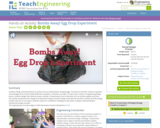
Students design and build devices to protect and accurately deliver dropped eggs. The devices and their contents represent care packages that must be safely delivered to people in a disaster area with no road access. Similar to engineering design teams, students design their devices using a number of requirements and constraints such as limited supplies and time. The activity emphasizes the change from potential energy to kinetic energy of the devices and their contents and the energy transfer that occurs on impact. Students enjoy this competitive challenge as they attain a deeper understanding of mechanical energy concepts.
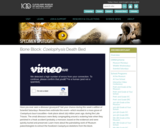
Have you ever seen a dinosaur graveyard? Get your chance during this week’s edition of Scientist Saturdays. Researchers estimate this event—which resulted in a mass grave of Coelophysis bauri casualties—took place about 225 million years ago, during the Late Triassic. The small dinosaurs were likely congregating around a watering hole when they perished in a freak accident (probably a monsoon, based on the evidence) and were quickly buried and preserved. Learn more about the painstaking work of Museum paleontologists to extract the fossilized Coelophysis skeletons from the block. Worksheets available for grades 7-8 and 9-12.